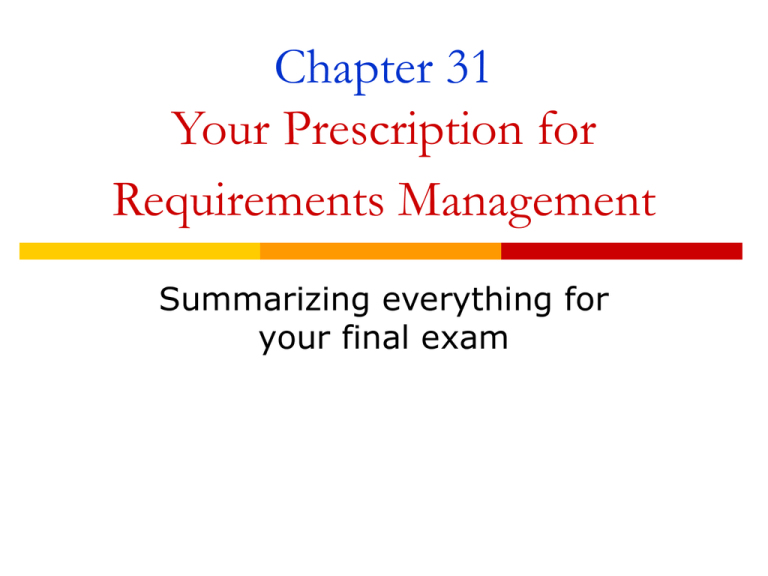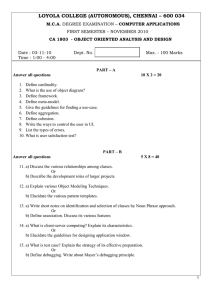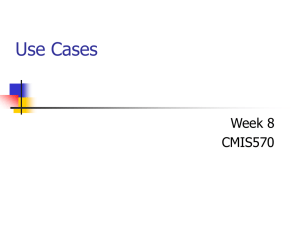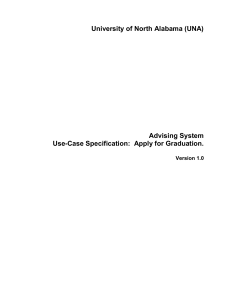Chapter 31 Your Prescription for Requirements Management Summarizing everything for
advertisement

Chapter 31 Your Prescription for Requirements Management Summarizing everything for your final exam Prescription for Requirements Management: Steps Step 1: Step 2: Step 3: Step 4: Step 5: Change Step 6: Step 7: Step 8: Get Organized Understand the Problem Being Solved Understand User and Stakeholder Needs Define the System Continuously Manage Scope and Manage Refine the System Definition Build the Right System Manage the Requirements Process Step 1: Get Organized A.Meet with your team and agree on the basic software processes you will employ. B.Decide how you will manage requirements on the project and document this process in a short oneto two-page requirements management plan. C.Decide what types of software tooling you will apply to the project. D.Determine a configuration management plan for your code and requirements artifacts. E. Establish an iteration plan and determine the basic project metrics and reporting disciplines. Step 2: Understand the Problem Being Solved A.Execute the five-step problem analysis process. 1. 2. 3. 4. 5. Gain agreement on the problem being solved. Write it down. Understand the root cause of the problem (if applicable to your situation). Identify the stakeholders and users, or actors, in your system. Define the system boundary. Document the boundary and the identified stakeholders and actors in a system context diagram or preliminary use-case model. Identify constraints imposed on the solution. Write them down. Step 2: Understand the Problem Being Solved B. Circulate the problem statement to external stakeholders and insist that you gain agreement on the problem statement before moving forward. Step 3: Understand User and Stakeholder Needs A.Create a structured interview using a generic template B.Interview 5–15 users/stakeholders identified in step 2. C.Summarize the interviews by aggregating the top 10–15 user needs. D.Use the quotes or the restated needs to start your requirements pyramid. E. Facilitate a requirements workshop for your project. 1. Run a brainstorming session to identify/refine features. 2. Perform idea reduction and feature prioritization. 3. Use the critical, important, and useful classification. Step 3: Understand User and Stakeholder Needs F. Rerun the workshop once or twice during the project to provide a format for ongoing customer input. G. Create storyboards for all innovative concepts. Present them, propose an initial set of use cases to your users, and get user feedback. H. Ensure that your process yields early iterations that the users can test in their environment. Step 4: Define the System A.Adopt the Vision document concept and create a template to suit your project's needs. B.Create a product position statement. Circulate it widely and make sure your customer agrees with it. C.Enter in the Vision document all features identified in step 3 and through other inputs. Trace these features back to user needs. Use attributes of priority, risk, effort, stability, and release. Define the commercial requirements (licensing, documentation, legal, regulatory, and so on) in the whole product plan. Step 4: Define the System D. Make the Vision document be the living document for your project. Publish it for easy access and review. Use a Delta Vision document as you move forward. E. Develop the use-case model for your project so that all stakeholders can see what actors the system supports and how it supports them. Step 5: Continuously Manage Scope and Manage Change A.Based on effort estimates from the team, determine the baseline for each release in the Vision document, using an attribute of "version number." B.Get customer agreement on scope. Help the team make the hard scope decisions and get the decisions behind you. C.Preach and teach iterative development. Build iterations monthly or weekly. Communicate and manage expectations everywhere. D.Manage change by using the baseline. Use the Delta Vision document to capture all new features that arise through the normal course of events. Make sure that all suggested features are recorded so that none are lost. Empower a change control board to make the hard decisions. Step 5: Continuously Manage Scope and Manage Change E. Install a change request management system to capture all requests for change, and ensure that all requests go through that system to the change control board. Step 6: Refine the System Definition A.Refine the use-case model, use-case specifications, and supplementary specifications to whatever level of detail is necessary to assure that your team members are all developing the same system. B.Have the development team and test team adopt and manage this workload. Assist them with training and find them help if they need it. Use formal analysis methods only when you cannot afford to be misunderstood. C.Trace nonfunctional requirements to and from use cases and features. Step 6: Refine the System Definition D. Ensure that you have discovered all the nonfunctional requirements for your system, including design constraints. The template you use should prompt you to make sure that you have asked the right questions. Step 7: Build the Right System A.Engage the test department in the requirements management challenge now. Have testers involved in test planning from the beginning. Have the test team review the use cases as they are developed, and look for additional alternative flows and events. Brainstorm potential exception conditions. Develop scenarios and test cases directly from the use cases. Determine a strategy for testing nonfunctional requirements. Step 7: Build the Right System B. Rely on the use cases and use-case realizations in the design model to integrate design elements with the requirements. Use implicit traceability through the use-case realizations for impact assessment as change occurs. C. Develop regression testing processes that are as automated and efficient as possible, with the goal being the ability to fully regression test the system at every new iteration. Step 8: Manage the Requirements Process A.The product manager or project champion should maintain responsibility for the Vision document, attend weekly reviews with the team to assess status, and set up default reports and queries to assist this effort. B.Monitor the software requirements management process to assure that the vision is fulfilled in the use-case model and in the implementation. C.Engage the quality assurance team to help monitor the requirements maintenance, change management, and test processes. Step 8: Manage the Requirements Process D. Participate or drive the change control process, assuring that impact is assessed before significant changes are allowed into the system. On to the Next Release! Now, go back to (about) Step 3-E and build the next significant release of your new product or system.


